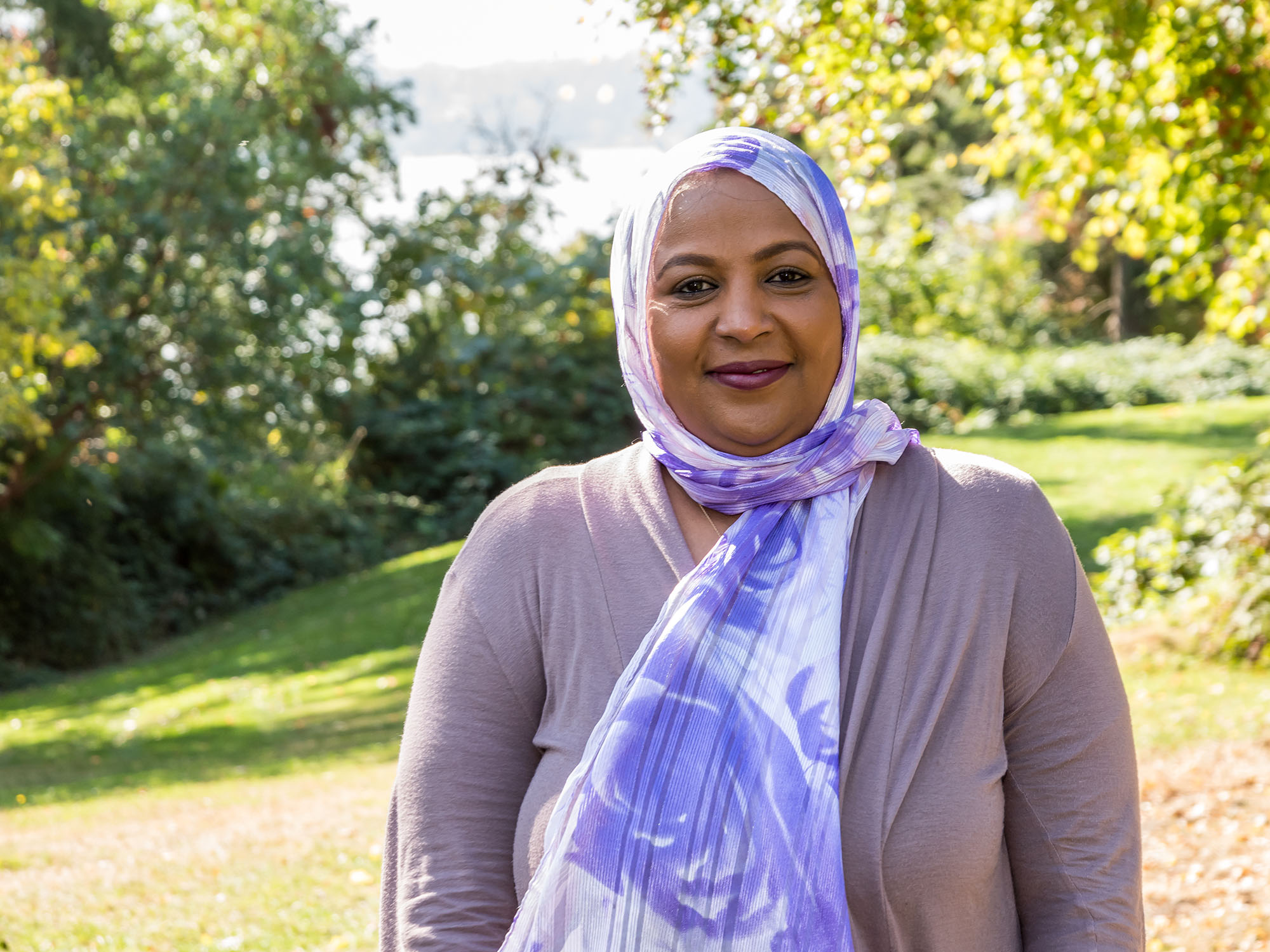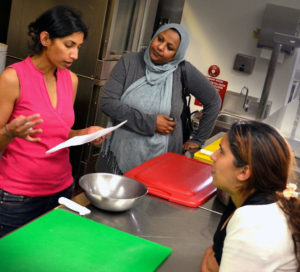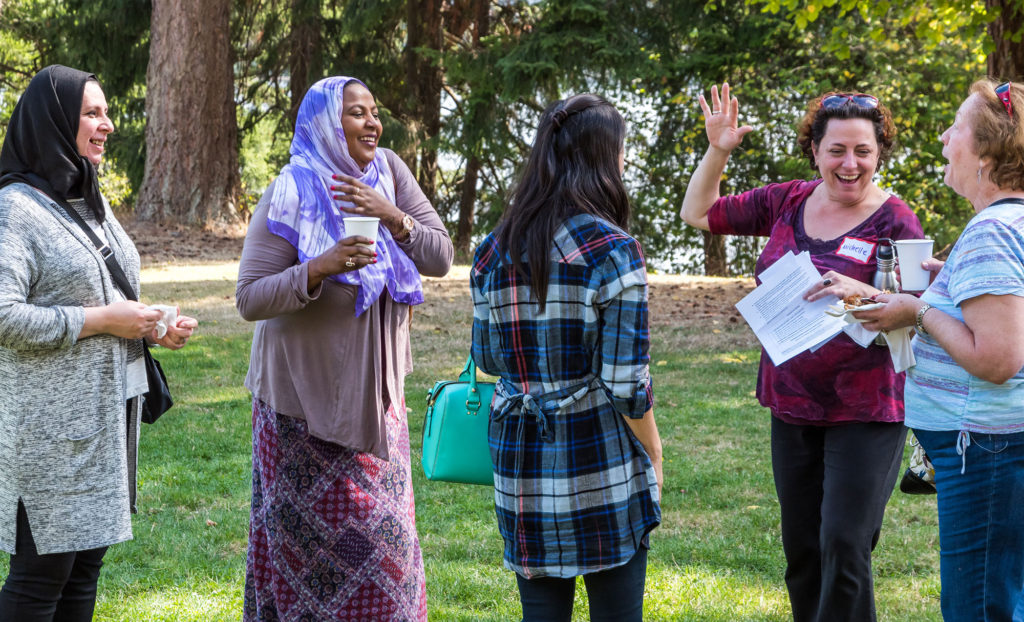Rehab Babiker:
Graduate of Project Feast’s first class, catering team cook 2013-2015

“I showed them how to make our traditional food, and others shared, too.”
Now an early-childhood teacher, Rehab Babiker still savors the friendships and foods she discovered during Project Feast’s earliest years.
The Eid al-Adha holiday is months away, but on this winter morning Rehab Babiker is sharing one of her family’s favorite dishes from the holiday feast. On a tablecloth from Sudan adorned with delicate gold and silver thread, she sets a plate of browned lamb spiced with black pepper, garlic and coriander and brightened with a splash of lemon. Loaves of bread are on the side to scoop up the meat. “In Sudan, we love lamb,” Rehab says. “That’s our favorite.”
Rehab remembers eating the dish, called lahama, with her family when she was a child in Khartoum, the Sudanese capital. Her bustling household included both grandmothers, along with Rehab’s three sisters and brother, and her memories are full of delicious foods the family shared. The lahama was often served with a spicy sauce, called shata, made from green pepper, peanut butter and lemon. “We made it like a choice. We love it spicy, but it’s a choice if you want to do it or not,” she says. “In my family, they all cook, and it’s so good.”
“Honestly, when I was young, I didn’t like to cook a lot,” Rehab says. “But when I was in middle school, I liked to be with my mom in the kitchen. After that, I became interested in making food, especially during the month of Ramadan when we were fasting and eating when the sun set. We cook a lot then, and I helped.”

Veena Prasad, left, and Rehab Babiker at a Project Feast workshop in 2013.
During her university years, Rehab studied accounting and she became an accountant in Khartoum. Then in 2009, she and her 6-year-old son moved to the Seattle area to join her husband, who had been working here as a driver for a few years. Their son joined his class at the start of first grade, where he quickly learned English.
The new language was more challenging for Rehab, who began taking English as a Second Language classes at Highline College. “In Sudan, we speak Arabic,” she says. “We also study English, like British English, but it’s like a subject, not like speaking. My English was horrible.”
In 2013, through the ESL classes, Rehab learned about Project Feast, which was just starting to offer culinary training to immigrants and refugees. Rehab was in the first group of students. “We were a group who all spoke Arabic, but we were from different countries,” says Rehab, who was grateful an interpreter was available. “I remember one lady from Morocco, some from Iraq. But I’m the only one who was Sudanese.”
“I learned a lot,” she says. “Before, when we cooked at home, we didn’t measure. We just put in whatever we knew we needed. In Project Feast, I learned how to measure, and I studied knife skills.”
During the program, which was just a few weeks long at the time, the group of students also learned how to sanitize a cooking space and visited a commercial kitchen in Seattle’s SoDo neighborhood.
After acquiring her food-handler’s permit, Rehab joined the Project Feast catering team, which sometimes prepared meals for as many as 100 people. She taught the other cooks to make tamiya – Sudanese falafel – and a dessert called kunafa. “I showed them how to make our traditional food, and others shared, too,” she says. Students from Iraq taught Rehab how to make biryani, which she still makes at home. “And now I cook with curry!” she says. “Before, I didn’t know about curry. It was a lot of fun to work together and share our food.”
Rehab continued to work with Project Feast until 2015, when she became busy with her studies in early-childhood education and caring for her family. She earned her certificate and is now a lead teacher. “I love this field and working with children,” she says.

Rehab and other Project Feast alumni attend the Potluck for Peace in 2016. (Photo by Sarah Gilbert)
While her job doesn’t leave time to work with Project Feast now, Rehab stays in touch with founder Veena Prasad and some of her friends from the nonprofit’s earliest years. And she loves to cook for her family and her large Sudanese community. “Especially on holidays like Ramadan, we make food together and we eat together, men and women, our children,” she says. The spread of food often includes a barbecue, fava beans, falafel, and desserts like kunafa, baklava and basboosa. “We have a party for our holidays. It’s really good.”
Rehab also enjoys swapping recipes with American and Mexican friends, and she’s become a fan of American foods like mac and cheese and pumpkin bread.
While Rehab enjoys her work and life in Seattle, she misses some of the energy of Khartoum. “Here, people never stay outside a lot in the evening,” she says. “In Sudan, because it’s so warm, at night they start their life. Twelve, 1 a.m., 2 a.m. you see people by the street eating and drinking. Life in the evenings starts after the sun sets. I miss that.”
But the foods of home help Rehab feel just a little closer to her family still in Sudan. She shares a WhatsApp messaging group with her brother and sisters, and the siblings chat daily. “Sometimes, if I miss something, I’ll ask my older sister, ‘Do you remember how we make that food?’ And she’ll tell me,” Rehab says. “Even my younger sister sometimes will call me and ask me about food. She lives in Sudan, but she will ask me.”
“On the holidays, my brother will use his camera to show me, with my dad and my sister, what they’re eating – and I show them, we are eating the same thing!” she says. “We have the fava beans, the falafel. I do the same for my family.”
– Featured photo by Sarah Gilbert. Interview and writing by Denise Clifton, Tandemvines Media
Kunafa
Ingredients
For the kunafa:
- 1 pound box shredded phyllo dough (kataifi)*
- 1 16 oz container peanuts, dry roasted or honey roasted
- 1/3 cup white sugar
- 2 cups ghee butter
For the syrup:
- 2 cups white sugar
- 1 cup water
- 1 tsp lemon juice
Instructions
To make the kunafa:
- 1. Use a food processor to finely chop the peanuts. Add the 1/3 cup of sugar and combine.
- 2. Place the shredded phyllo dough in a bowl, and place the ghee butter in a large liquid measuring cup or bowl with a spout. Heat the butter in a microwave until completely melted. Use your hands to mix the dough with 1 1/4 cup of the melted butter. Add ½ cup of melted butter to the chopped peanuts mixture. Reserve the last ¼ cup of butter.
- 3. Evenly spread half the buttered phyllo dough into a 9x13-inch pan and firmly press it into the bottom and edges.
- 4. Spread the peanut mixture onto the dough, avoiding the edges of the pan.
- 5. Spread the second half of the phyllo dough on top to cover the layers. Brush the last ¼ cup of melted butter over the top.
- 6. Bake in the preheated oven until golden – about 30 to 40 minutes.
While the kunafa is baking, prepare the syrup:
- 1. Combine the water and 1/2 cup sugar in a small saucepan. Bring the mixture to a boil over medium-high heat. Reduce the heat to medium and stir in the lemon juice. Simmer, stirring constantly, until the sugar is dissolved and the mixture is thickened, 5 to 7 minutes. (Do not let the mixture turn golden.)
- 2. Remove the kanafa from the oven. Using oven mitts, carefully invert the baking dish onto a platter. Pour the syrup over the kunafa. Cut into pieces and serve while hot.
- *Shredded phyllo dough (kataifi) is available in the freezer section in many grocery stores
Tamiya (Sudanese Falafel)
Ingredients
- 1 lb, 8 oz dried chickpeas
- 1 white onion
- ⅓ cup garlic
- ¼ oz fresh dill
- ¼ oz parsley
- ¼ oz cilantro
- 1 tsp baking powder
- 3 tsp salt
- ¼ cup water
- 2 eggs
- 1 tsp black pepper
- 1 tsp ground coriander
- 1 tsp sesame seeds (Optional)
- Mazola oil for frying
Instructions
- 1. Soak chickpeas in water overnight. Drain the water completely.
- 2. Chop drained chickpeas, onion, garlic, dill, parsley and cilantro in a food processor to a uniform coarse consistency. (Don’t over-mix or the dough will be too soft.) Add baking powder, salt, water, eggs, black pepper and coriander. Mix thoroughly.
- 3. Fry the tamiya: You need a deep heavy-duty frying pan or a fryer. Pour oil onto pan and heat oil. Make 2-inch-wide patties and fry in the oil. Tamiya must be deep fried at medium heat. Make sure the oil is deep enough so it does not stick and burn the bottom. Fry until golden.
